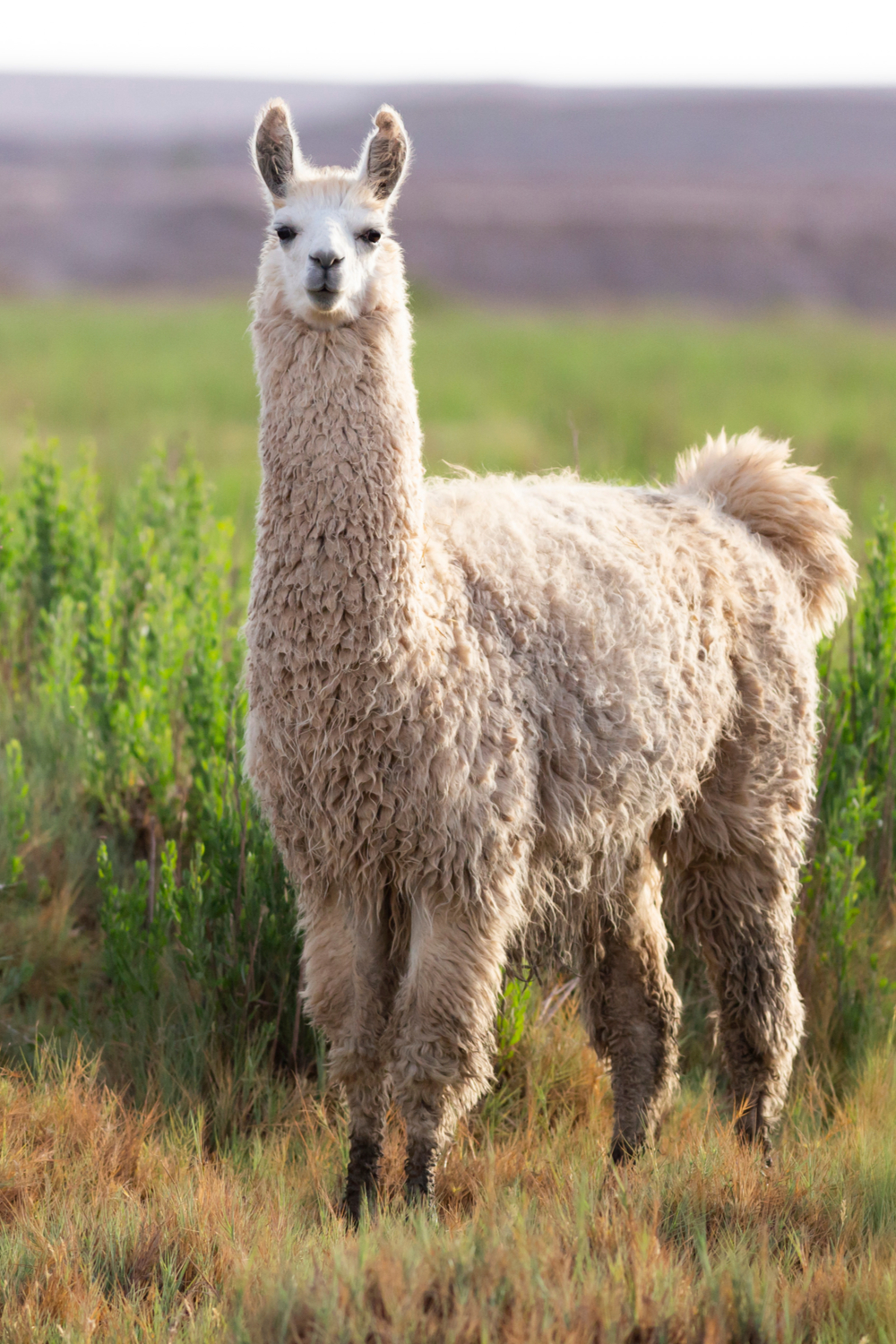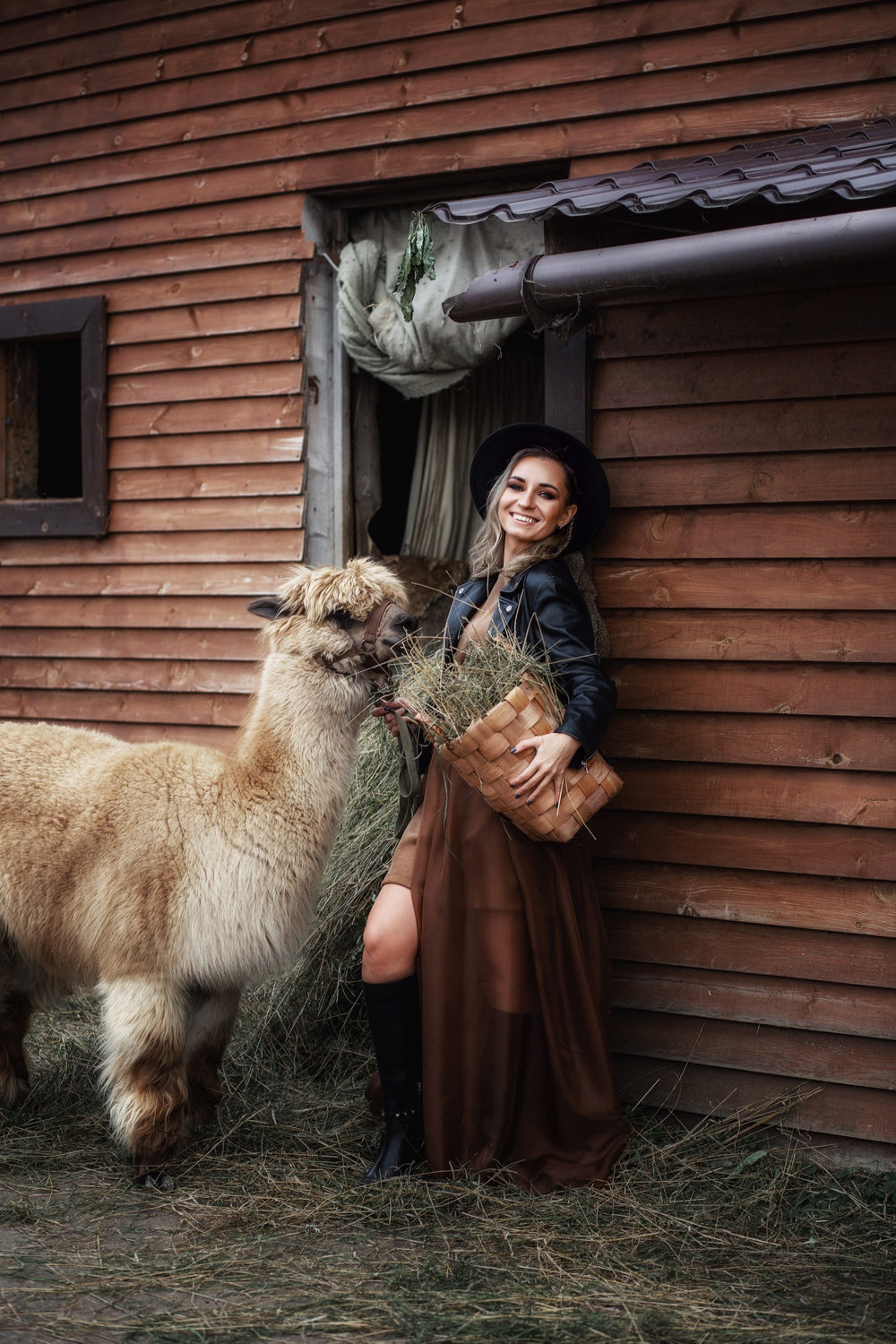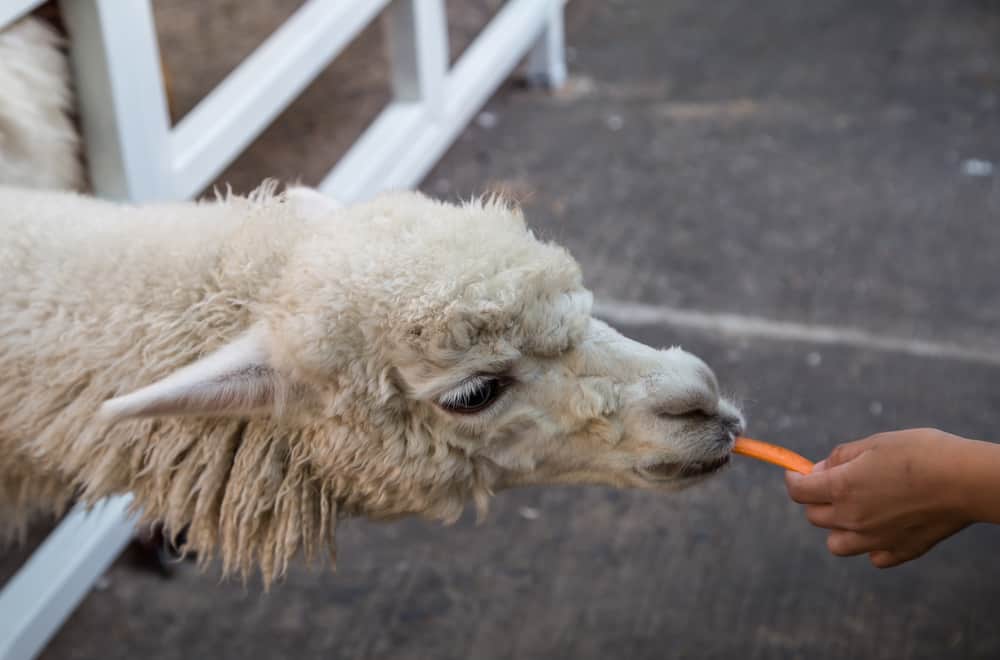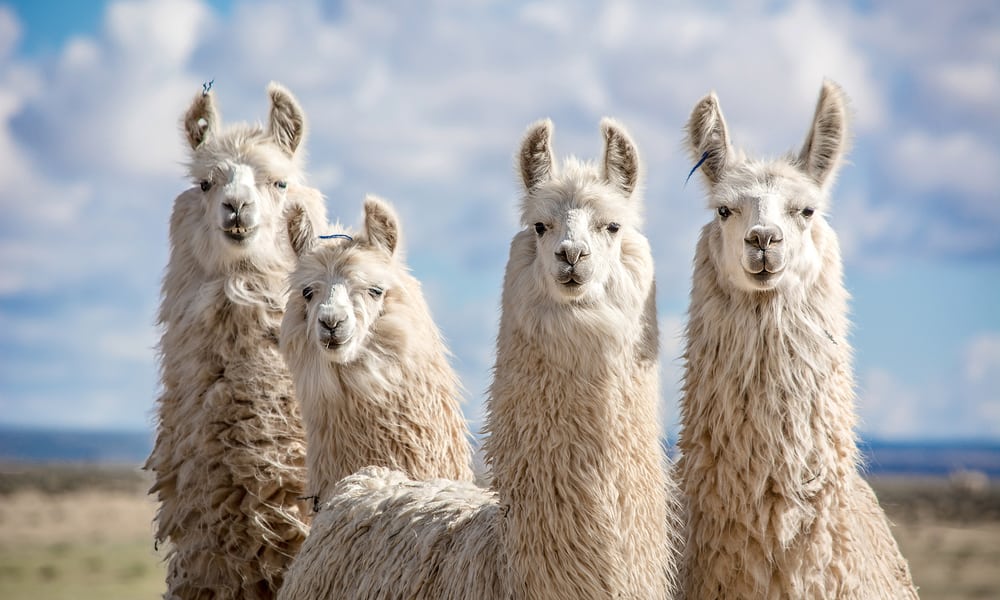Nowadays, there are no llamas in the wild, so they are considered livestock. Therefore, their diet is entirely on their owners but needs to follow their needs and habits from nature. It is known that these animals require 25% less food than cows, but the question is, what do llamas eat. Let’s take a look.
Llamas Habits, and Biology

Llamas are camel relatives from South America without a hump. The native peoples of the Andes Mountains used them as pack animals for centuries. This hardy creature can travel 20 miles (32.2 km) a day, carrying a load of 50 to 75 pounds (22.7 – 34 kg) on its back.
However, an overloaded animal will refuse to move, so the only solution is to relieve it. An average llama can run at an average speed of 28 mph (45 km/h).
Llama types |
|
| Scientific classification | Llama |
| Kingdom | Animalia |
| Phylum | Chordata |
| Class | Mammalia |
| Order | Artiodactyla |
| Family | Camelidae |
| Genus | Lama |
| Species | Lama glama |
Nowadays, llamas are exclusively domestic animals and even pets, and you can’t find any in the wild. They are spread throughout the Americas, Europe, and even Australia.
An average llama weighs 250 pounds (113.5 kg) and can grow to 47 inches (120 cm) at the shoulders. They typically have shaggy pelage, and you can see them in several coat color varieties, including:
- Most common reddish-brown with white or yellow patches
- White
- Tan
- Black
These animals are polygynous and mate yearly, from November to May, even though females don’t have an estrus cycle. Each male gathers six females into its territory, drives away other mature males, and can be pretty aggressive in that period.
Mothers give birth to one 22 pounds (10 kg) heavy baby (cria) each year after pregnancy of 360 days. The cria will stand and start suckling within half an hour after delivery and run after an hour. Moms will nurse their babies for four months and look after them for about a year.
Interestingly, llamas can interbreed with other Lama genus members, and their offspring is fertile.
The llama is a unique animal in many ways. Unusual traits include oval-shaped red blood cells and low hemoglobin values that allow this animal to live in high-altitude habitats with reduced oxygen levels.
Believe it or not, these animals can live at 13,100 feet (4,000 m) above sea level. Their two-toed feet with a sole covered by thick leathery pads allow llamas to move through inaccessible mountainous areas.
There is one more uniqueness. Adult llamas have distinctive teeth and retain only one upper incisor. They use lower incisors to clip vegetation and chew it by using hardened gums. Their lifespan is about 15 to 25 years.
What Do Llamas Like to Eat Most?
As I have already mentioned, llamas are fully domesticated animals, and you can’t see them in the wild anymore. They ate wild shrubs, fruit, and weeds in nature, so you should adjust their diet according to their natural needs.
Daily food requirements |
|
| Type | Daily requirements |
| Dry food | 1 to 1.3% of its body weight |
| Crude protein | 0.008 pounds (3.5 g) x bodyweight |
| Calories | 60 to 85 kcal per 2.2 pounds (1 kg) |
According to the National Research Council, llamas need 1,100 calories and 0.1 pounds (50 g) of protein per 100 pounds (45.5 kg) of their body weight.
Therefore, it is necessary to provide 1 to 1.3% of the dry food to llamas’ body weight. In other words, it will require 1 to 1.3 pounds (453.5 – 590 g) of dry food per 100 pounds (45.5 kg) of their body weight.
Grass types for llamas |
|
| Tropical (warm) grass | Temperate (cool) grass |
| Corn | Annual and perennial ryegrass |
| Bermuda grass | Orchardgrass |
| Dallisgrass | Kentucky blue-grass |
| Bahia grass | Fescue grass |
| Timothy grass | |
Llamas are herbivores that enjoy various food, including:
- Grass
- Leaves from trees, shrubs, and bushes
- Blackberries, strawberries, and raspberries
- Bananas, oranges, and grapes
- Watermelon, melon, and mango
- Squash
- Apples, pears, and pineapples
- Beets, carrots, broccoli, and sweet potatoes
- Celery and green beans
On the other hand, you should avoid offering these animals ingredients like:
- Avocado
- Stone fruits like peaches, cherries, apricots, and plums
- Potatoes, brassicas, peppers, tomatoes, kale, and eggplants
- Lupins
- Processed human food, such as bread and crackers
- Meat and other animal products
- Chocolate
Food Avoid to Feed Llamas

Unfortunately, some food is poisonous for llamas, so you should be careful when offering these ingredients. Remember that some toxins can jeopardize your animal even ingested in traces.
Always check the Global Toxic Plant Database and determine plants toxic for this species. Besides the list of poisonous plants, you should consider some other potentially harmful toxins for llamas, including:
- Algae – Blue-green algae from stagnant water can be toxic for llamas during hot summer days when temperatures are high.
- Blister beetle poisoning (Cantharidiasis) – Any of 200 different blister beetle species contain the toxic chemical cantharidin that can severely jeopardize llamas’ health and even kill them.
- Grain poisoning (acidosis) – This condition is common when llamas consume grain in large amounts. In such a case, carbs will start fermenting instead of digested, and lactic acid will slow the gut down and cause dehydration and sometimes even death.
- Sweet food – Never offer ingredients high in sugar and starch to prevent acidosis and bloat.
- Herbicides, pesticides, and rodenticides – These chemicals cause toxicosis and probably death in llamas after ingesting. Therefore, never feed your animal on pastures treated with them. Moreover, herbicides such as Roundup, Paraquat, and many others are not only harmful to animals but also pose risks to human health. In fact, there have been several documented cases and an ongoing lawsuit linking Roundup exposure to non-Hodgkin’s lymphoma, which further underscores the potential dangers associated with its use.
- Copper – Never allow llamas free access to mineral salt blocks to prevent copper poisoning. Plus, avoid offering them food that contains this mineral in high amounts, like cow and pig minerals and chicken food.
- Lead – Some pesticides and paints contain lead highly poisonous for llamas. Therefore, you should always pay attention to old barns and fences painted with old paints.
- Selenium – This mineral is toxic when taken in higher amounts than this needed for regular metabolism. It is wise to check its levels in the soil before deciding to grow llamas.
- Mycotoxins – These mold products are harmful to most animals, including llamas. Always keep food and bedding clean and fungi-free to keep your animals healthy.
- Snakebites – Venomous snakes won’t commonly bite llamas, but you need to treat the wound immediately if such a thing happens.
- Hardware disease – Keep your llamas on an eye and ensure they can’t reach and consume nails, staples, or screws that can hurt them.
If you face with llama poisoning, the first step is to offer charcoal to your animal. Remember that it is not a magic cure, and you should only use it to help llama while waiting for a vet.
Tips to Feed Llamas

It is pretty challenging to determine the exact amount of food an adult llama needs, but you should evaluate some average values. It is crucial to ensure enough protein and fiber and provide the required number of calories for each animal.
Best food options for llamas |
|||
| Food type | Crude protein | Fiber | |
| Grains | Corn | 10% | 2.4% |
| Oat | 13.5% | 12% | |
| Cottonseed | 20% | 20% | |
| Straw | Oat | 3% | 40% |
| Hay | Oat | 9.5% | 30.5% |
| Timothy | 8.5% | 33.5% | |
| Alfalfa | 18% | 26% | |
| Brome grass | 12% | 31% | |
You can quickly check the crude protein on the package if you decide to feed your llama with pellets. It is quite different when choosing to offer the food you produce. Always check the nutritional composition of the selected ingredients and recalculate the necessary daily amounts.
Fresh grass contains all the necessary nutrients for llamas, so there is no reason to worry while they spend time outdoors. However, you will probably need to add some sufficient nutrients during the winter when the llamas’ primary food is hay.
Take care that the food consists of enough nutrients in appropriate proportions, like:
Vitamins
- Vitamins A, D, E, and K
Macronutrients
- Calcium and phosphorus
- Sodium and potassium
- Magnesium and sulfur
Micronutrients
- Iron and zinc
- Manganese and copper
- Molybdenum
Keep in mind that hay is deficient in vitamin E. On the other hand, llamas’ bodies produce enough B vitamins and get vitamin D from the sun.
Remember that it is necessary to adjust food for llamas in specific situations, such as:
- Late pregnancy and lactation
- Babies under two months of age and bottle-fed babies
- Obese or malnutrition
- When deciding to change their food
- Extreme weather conditions
Supplements
Besides commercial pelleted food you can offer your llama, it is necessary to add some supplements to keep it healthy and prosperous, including:
- Salt and mineral blocks as free choice
- Loose salt and minerals in a case of extreme nutrient deficiency
The supplement type you choose will depend on the food quality, and the quantity llamas eat daily. The best option is to let it regulate the necessary amount on its own.
Water
Llamas require unlimited access to clean water, but be careful. This animal will refuse to drink from a dirty bucket.
Summary
Most people don’t know about llamas’ diet and habits. If you decide to farm these useful animals, you should check about their needs. Any lack of valuable ingredients may lead to health issues. In most cases, they will be satisfied with mountain vegetation, shrubs, and lichen but will also enjoy nibbling grains, fruit, nuts, seeds, roots, and veggies.
